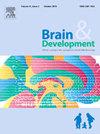Development of a manual for an upper extremity intensive rehabilitation program for pediatric hemiplegia in Japan and assessment of its effectiveness and usability
IF 1.3
4区 医学
Q4 CLINICAL NEUROLOGY
引用次数: 0
Abstract
Objectives
The aim of this study was to develop a manual for an upper extremity intensive rehabilitation program for pediatric hemiplegia in Japan, and to clarify its effectiveness and usability.
Methods
The manual was created through discussions among nine experts with sufficient pediatric clinical experience in Japan. A total of 39 children with hemiplegia aged 2 to 16 years underwent 44 intensive therapy sessions using the manual. Each child's upper limb function was assessed pre-, post- and 6-month after the intervention using the Canadian Occupational Performance Measure (COPM), ABILHAND-Kids, the Quality of Upper Extremity Skills Test (QUEST), and Box and Block Test (BBT). Questionnaire assessments were also conducted to evaluate usability of the manual.
Results
All four indices showed statistically significant improvements from pre- to post-intervention; COPM improved by 4 points in both performance and satisfaction; the ABILHAND-Kids logit score improved by 0.78; the total QUEST score improved by 2.8 in total score; and BBT improved by 5 on the affected side and 6 on the non-affected side. These effects were maintained 6 months later. Most therapists responded that the manual is useful, and most children and their parents were satisfied with the rehabilitation.
Conclusions
An upper extremity intensive rehabilitation program for pediatric hemiplegia using our manual was clinically effective. The manual was useful for therapists, and the level of satisfaction among parents and children who received the therapy was high.
日本小儿偏瘫上肢强化康复方案手册的制定及其有效性和可用性评估
目的:本研究的目的是为日本儿童偏瘫的上肢强化康复计划制定一份手册,并阐明其有效性和可用性。方法本手册由9位在日本具有丰富儿科临床经验的专家共同编写。共有39名2至16岁的偏瘫儿童使用该手册接受了44次强化治疗。采用加拿大职业表现量表(COPM)、ABILHAND-Kids、上肢技能质量测试(QUEST)和方块测试(BBT)对每位儿童的上肢功能进行干预前、干预后和干预后6个月的评估。还进行了问卷评估,以评估手册的可用性。结果干预前后4项指标均有显著改善;COPM绩效和满意度均提高4分;abili hand - kids logit得分提高0.78;QUEST总分提高2.8分;患侧BBT提高了5分,非患侧BBT提高了6分。这些效果在6个月后保持不变。大多数治疗师回应说手册是有用的,大多数孩子和他们的父母对康复感到满意。结论采用本手册设计的小儿偏瘫上肢强化康复方案具有较好的临床效果。该手册对治疗师很有用,接受治疗的父母和孩子的满意度很高。
本文章由计算机程序翻译,如有差异,请以英文原文为准。
求助全文
约1分钟内获得全文
求助全文
来源期刊

Brain & Development
医学-临床神经学
CiteScore
3.60
自引率
0.00%
发文量
153
审稿时长
50 days
期刊介绍:
Brain and Development (ISSN 0387-7604) is the Official Journal of the Japanese Society of Child Neurology, and is aimed to promote clinical child neurology and developmental neuroscience.
The journal is devoted to publishing Review Articles, Full Length Original Papers, Case Reports and Letters to the Editor in the field of Child Neurology and related sciences. Proceedings of meetings, and professional announcements will be published at the Editor''s discretion. Letters concerning articles published in Brain and Development and other relevant issues are also welcome.
 求助内容:
求助内容: 应助结果提醒方式:
应助结果提醒方式:


